Just before noon on a recent Sunday morning, several cars pulled up in front of a nice but unremarkable house in Arlington. The drivers – all men in their 30s, 40s, and 50s – got out, grabbed their gear, and headed through the garage and out to the backyard.
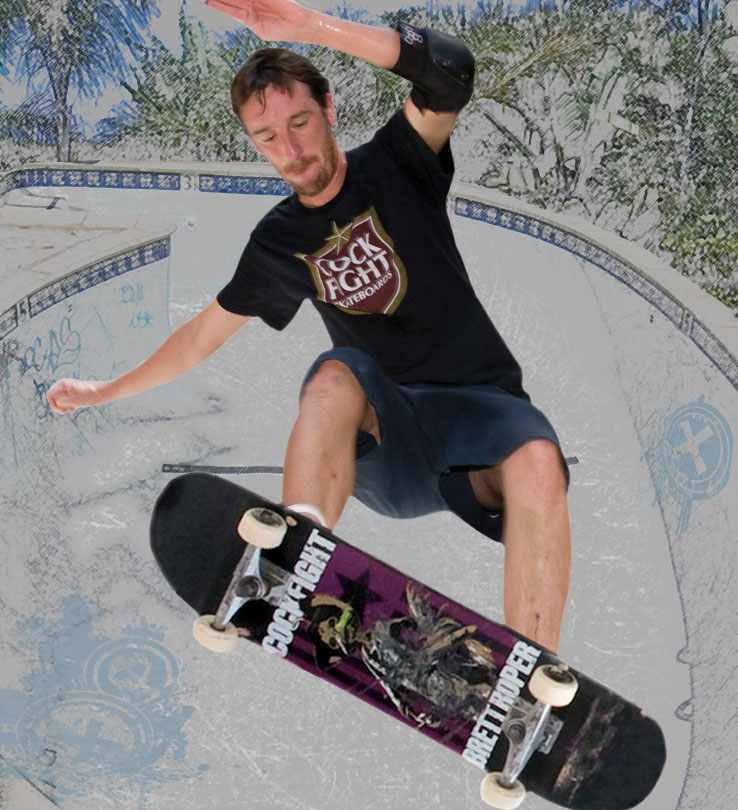 “Oh, man, this is great!” said one.
“Oh, man, this is great!” said one.
Another wasn’t quite so enthusiastic. “I don’t know if my back is up to it,” he said.
“The heck with your back,” said a third member of the crew. “What about my broken toe?”
The men stretched; some put on knee pads, a couple put on helmets. They looked admiringly at the empty concrete swimming pool.
“She’s a beauty, isn’t she?” someone said.
Suddenly, one of them stepped down the three stairs into the shallow end, dropped a skateboard, stepped on, pushed off, and began racing toward the 11-foot wall less than 40 feet away. In a split-second maneuver that meant the difference between slamming into the wall or climbing it, the skater tipped his board and shifted his weight at the moment of impact, his speed propelling him up the wall, his body horizontal. He made a right-angle turn near the top, then another a moment later to zoom back down the wall. Transitioning again from horizontal to vertical at the bottom, he flew back up the pool to the shallow end.
“This is gonna be a great day. I feel it,” he said to no one in particular.
At an age when most athletes decide they like fishing or watching sports rather than playing them, these guys and hundreds like them around Texas are still skateboarding, still routinely risking life and limb for the few seconds it takes to skate a pool or run a drainage ditch or catch air on a vertical ramp. To a man they’ll tell you that those few seconds are indescribably delicious. Some even say that the moment when everything can go wrong, that moment when their body and board must work as a unit to prevent calamity, is akin to the high of meditation.
Over the course of the next two hours, the nine men, one teenager, and one guy’s 8-year-old son took turns flying around that pool. Nobody’s turn lasted more than 10 or 15 seconds – pool etiquette, combined with the physical difficulty of maintaining sufficient speed, set the limits. Once every few runs, someone would reach the pool’s coping, the top edge, and run his rear axle along it, making a screeching sound and sending sparks flying. The move is called grinding and for a lot of skateboarders is the ultimate high. Each time someone did it, the others would cheer or clap with the enthusiasm of home team fans.
More frequently someone would try a trick move that ended with the quick thud of a body hitting concrete. Most of the falls produced scratched-up knees or elbows. Sometimes it’s worse. Nearly all the nine older skaters could list broken bones, surgeries, and concussions suffered on the unforgiving concrete surfaces they like to skate. But they all said it was worth it – even the guy with the stiff back.
“It’s the greatest feeling in the world,” he said.
Though they don’t think of themselves as high-caliber athletes, the crew gathered in Arlington that Sunday morning certainly were. Most of them still get at least some sponsorship as emissaries for the sport. One of the Sunday skaters, John Comer, made a good living as a pro for several years. And though they all now have day jobs, they still find the time to skate several times a week.
“I couldn’t live without it,” said Greg Stubbs, a 42-year-old who co-owns a legal document search firm in Dallas. “I watch other people running on the treadmill and think I’d go crazy if I had to do that. I’d rather skate. You don’t need anything but your board and a place to skate.”
Those places include skate parks, malls after closing, drainage ditches, highway underpasses and – when they’re lucky – a pool like this one.
“We’re too old to be jumping fences or sneaking into backyards and using pools when people go on vacation,” Stubbs said. “So what we do is try to find someone with a pool they’re not using, and we ask them if we can skate it. We offer them a little money for the privilege. Some people think we’re crazy or are going to rob them, but some people, like this family, say OK. We’ve used this pool several times.” The boarders sign liability wavers for such pay-to-play pools, said Stubbs, who has been skateboarding as long as he can remember.
Pools are his preferred venue. “Every pool is different, so each one has its challenges,” he said. “This one has that 11-foot monster wall; others have different shapes. This is definitely one of my favorites because you go from about three feet to 11 feet so quickly and then have to make that little adjustment that allows you to climb, rather than just slam into that thing.”
Chance Lehman, at 35 one of the youngest members skating that day, agreed. “Pools and ditches are pretty much all I skate these days,” he said. “I’m more about carving lines than doing all the tricks that a lot of guys do. Some guys love those vertical ramps you’ve seen on television, the ones that look like huge three-dimensional U’s. I just get bored with the back-and-forthness of that.”
Lehman, who works as a materials designer for intra-ocular lenses (used in cataract surgery), is one of those who used to jump fences to borrow pools. “I fit into that category. You find an empty pool and skate it ’til you get run off. My dad was a cop in Arlington – I grew up in North Richland Hills – so I got away with some things because I knew a lot of [the officers]. I also knew how to talk to them and how not to run my mouth.”
Even now, he admitted, an empty pool is hard to resist. “But these days when the cops come, they just can’t quite believe they’re looking at someone who’s probably older than a lot of them. They generally just tell you you’ve got to go, because you’re not damaging anything.”
Mike Nieman, 39, drove up from Houston with his son, Matt, for the pool skate. He was in the first wave of street skating in Texas, which means he rode on streets, curbs, building railings, anything his skateboard could roll on. “I’ve ridden everything – pools, ramps, rails. You’d hear about something and go search it out. The ‘permission’ pool is pretty rare. Usually it’s trespassing in pools in houses that have been foreclosed. You’d see a pool with black water and pump it out, clean it up, and then skate for 15 to 20 minutes, until the authorities came. I’ve been busted three times, but each time I was just told to get out of there.”
Lou Statman, 41, was one of the few who bothered with a helmet on Sunday. “Just last year some of us were riding a drainage ditch out toward D/FW airport. The police showed up, and the oldest cop was probably 38. We probably averaged 44,” he recalled, laughing. “There was just a dazed look on their faces as they asked us to leave. Which we did.”
More recently he was stopped by law enforcement officers when he and others were riding hills on a highway during a sunrise run near Weatherford. “I told him we were under the speed limit, but we still had to go.”
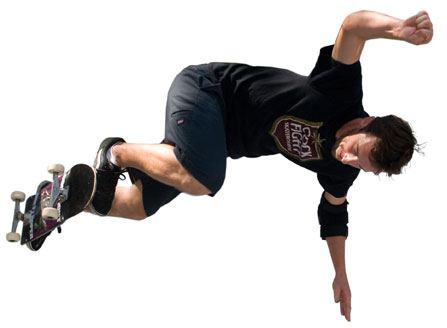 Only once did an officer give him a hard time. That was in Plano, a couple of years ago. “We found this pool and cleaned it out. It was nothing but a mosquito trap anyway. A neighbor called the police, and this one officer was just in our faces, as gung-ho as could be. We treated him with respect, but he was just looking for a confrontation. Fortunately, his superior showed up, and when he saw that we weren’t robbing the house or anything, he sent him back to the car. But the rude cop was the exception, not the rule.”
Only once did an officer give him a hard time. That was in Plano, a couple of years ago. “We found this pool and cleaned it out. It was nothing but a mosquito trap anyway. A neighbor called the police, and this one officer was just in our faces, as gung-ho as could be. We treated him with respect, but he was just looking for a confrontation. Fortunately, his superior showed up, and when he saw that we weren’t robbing the house or anything, he sent him back to the car. But the rude cop was the exception, not the rule.”
Most of the guys said they ride at skate parks now and then, but they don’t really like them. “Skate parks are great, and we’re all for municipalities building them,” Stubbs said, “but some of us see them as being asked to color inside the lines, and while we’re not bad guys, we don’t always want to color inside the lines.”
While Texas isn’t California when it comes to skateboarding – it was invented on the West Coast, after all – the state does have a rich history with the sport. It hit here in the late 1950s and slowly gained popularity. In the 1970s private skate parks, began to open up, only to close in the early ’80s because of liability issues. Skateboarders had to find other places to practice their passion.
“If you skated between 1980 and 1990, you were hated,” Stubbs said. “People in the ’80s saw skating as a rebellious thing. It was its own counterculture. Skaters had tattoos before anybody but guys in prison and motorcycle gangs had them. They were cutting-edge before that phrase was invented. They skated where they wanted, trespassed, got beat down by jocks who thought we were all faggots.
“But look at it now. Now jocks not only play sports but have their boards as well.”
Three skateboard luminaries came out of Texas during that period: Jeff Phillips and Craig Johnson from Dallas and John Gibson from Houston. “Those guys are legends,” Stubbs said. “And Phillips was the best of them. He’s probably the only guy who ever beat Tony Hawk and Christian Hosoi – acknowledged as two of the best skateboarders ever – in the same vertical ramp competition.”
Phillips died in 1993, Stubbs said, but Gibson and Johnson are so respected that even California skaters still ask how they are. Both are fine, Stubbs said. “Johnson works construction in Dallas, and Gibson plays in a couple of rock bands and was involved in raising the funds to get Houston’s new skate park open.” And both still skate.
Just asking about Texas greats is “a lot for California skaters,” Stubbs said. “They have a history of not showing Texans a lot of respect.” A rivalry started between the states during the 1980s, he explained. Before the internet, news about when and where contests were being held was spread by word of mouth. “And the skaters in California didn’t always bother to tell the Texans about them,” he said. “We sometimes didn’t even hear about them until after they happened. So the Texas boarders showed up at one contest wearing t-shirts that had ‘Fuck You! We’re from Texas!’ printed on them.
“That sort of defines how Texas boarders skate, too: It’s an in-your-face, aggressive, get-out-of-my-way type
of skating.”
It wasn’t until the early 1990s that modern concrete skate parks came along, and even that started out as an
outlaw event.
“Some guys started building a concrete park under a bridge in a crummy part of Portland [Ore.]. But when the authorities tried to shut them down, the neighborhood told the authorities to let them stay. Seems the locals gave the boarders credit for ridding the neighborhood of derelicts and drug dealers. So the authorities told them to go ahead and do what they wanted,” Stubbs said.
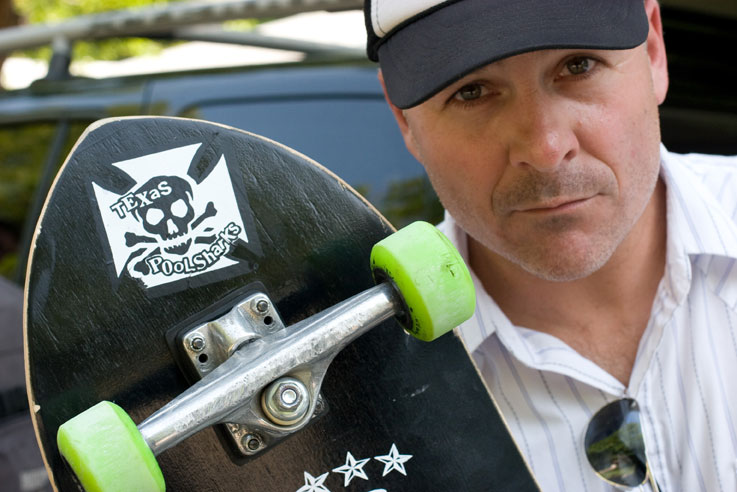 However, most cities refused to get into the skate park business because of liability problems. California was the first state to pass laws making use of skateboard parks an issue of ‘assumed liability’ – that is, skaters accept liability for what happens in a public park and cannot sue the municipality. In 1999, Texas followed suit. Since then nearly 30 concrete skate parks have been built across the state.
However, most cities refused to get into the skate park business because of liability problems. California was the first state to pass laws making use of skateboard parks an issue of ‘assumed liability’ – that is, skaters accept liability for what happens in a public park and cannot sue the municipality. In 1999, Texas followed suit. Since then nearly 30 concrete skate parks have been built across the state.
One of the driving forces behind that development was a web site called txpoolsharks.net, created in 1999 by Ron Ripper, 39, another of the Sunday pool skaters. “I loved pool skating and thought that if I created a web site for it, I might find out about some good pools to skate. That got a network going,” he said. “And some of it helped open the lines to get skate parks open.”
Through the web site, a boarder named Carter Davis organized others to support the parks. “He’s the guy who found out when and where public hearings on skate parks were going to be, and he’d organize e-mail campaigns and get skaters there,” said Stubbs. “He’s really the point man on those, but I don’t think that would have happened or the whole Texas scene of the last decade would have happened without Ripper’s site. That brought us all together.”The resurgence of skateboarding hasn’t been limited to Texas. Statman points out that there are more than 20 million skateboarders in this country now. “It’s a cyclical thing, but right now skateboarding has never been bigger,” he said. Among people under 25, it’s actually the third most popular sport – behind football and basketball and ahead of both baseball and soccer.
Not everybody is thrilled about that. “For those of us who have been skating for years and years, it’s a watering-down process because of the new skaters,” Stubbs said. “A lot of guys would like to keep this an outlaw experience. They get bored with skate parks because you’re told to skate there and only there. But boarders want to explore the world and see where they can roll. That’s why kids go to the mall after it closes and ride down stairs or rails. It’s the adventure. And once you’ve conquered a place, you move on.”
But that’s exactly why a lot of people don’t like boarders, isn’t it?
“Yeah,” he acknowledged. “And a lot of boarders use the phrase ‘skate and destroy,’ too, which doesn’t make friends. But I don’t think skaters are out to destroy property – they’re just looking for the next best place to skateboard.”
Boarders like Stubbs, Ripper, and Statman get free products from skateboard equipment companies in return for putting on demonstrations and just being seen using the companies’ stuff. But John Comer was the one skater at the Arlington pool who actually made a pretty good living at the sport for a while. His success was even more remarkable considering that all of his skateboarding has been done with one real and one artificial leg.
He started skating when he was 10 and his older brother got a board. When he was four years old, Comer was in a car wreck that left him with a mangled right foot. After repeated surgeries failed to repair it, his foot was eventually amputated when he was eight. The injuries also left his right leg shorter than the other, so he was fitted with a prosthesis for his lower leg and foot.
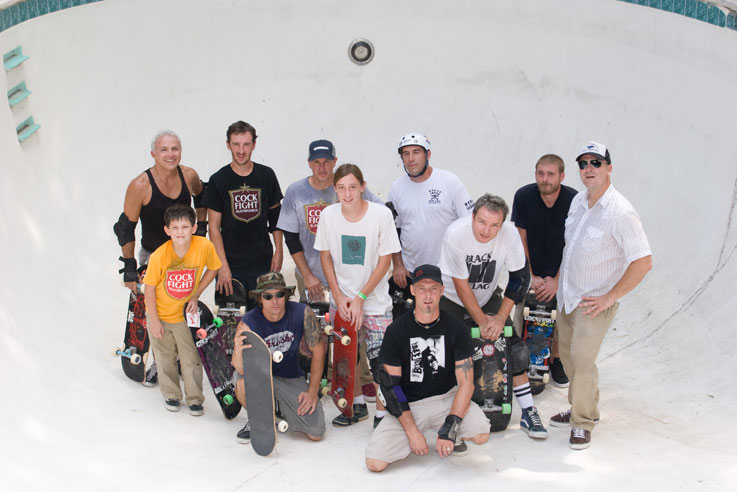 “The Scottish Rite Hospital in Dallas fitted me with my first leg, and they always encouraged me to do whatever I wanted,” Comer said. “To me that included skating.” The completely free hospital is run by the Shriners for Texas children with certain illnesses and other physical problems.
“The Scottish Rite Hospital in Dallas fitted me with my first leg, and they always encouraged me to do whatever I wanted,” Comer said. “To me that included skating.” The completely free hospital is run by the Shriners for Texas children with certain illnesses and other physical problems.
Over the following decade, the hospital became like a second home to him as he returned for frequent visits, including to get new prostheses as he grew. The doctors tinkered with the equipment to make his artificial foot and leg work for skating. And he got good enough at skating to turn pro. “I was a skate park rat when I was a kid, and to me the leg wasn’t an issue. The other skaters didn’t bring it up much either.”
Through his teens he always found sponsors. Eventually, Powell Skateboards, a major company, picked him up. “I skated for them for two or three years, and then they turned me pro. Initially I got travel expenses to go to contests and such. And since they make everything, I got a lot of product. And then you start to win, and there’s some money. I had a pretty good career for six or seven years.”
In his top year he earned $70,000, not chump change but also not what Tony Hawk or the other top skaters made. “Some of those guys made a million dollars a year,” comer said. “All the very top guys, maybe 15 or 20 or them, have corporate sponsorship. They’re the guys you see on television all the time – they make NFL money – and I was never in that league.”
During those years, he helped market Powell products to kids at demonstrations and competitions. In the process, he got to see the world, visiting every continent except Antarctica. The travel was great, but the demands of the pro circuit eventually bored him. “I broke my stump once, my tibia, and as soon as it healed, I did two months straight competing on the vertical ramp, and that just got old. It just wasn’t fun for me anymore.”
Though he retired from the pro circuit after that, Comer still earns equipment by appearing in ads in skateboarding magazines. He manages the Woodward Skate Park at Grapevine Mills, but pools are his favorite. “Everything happens so fast in a pool you’ve really got to be on it. The vert ramps are so super-smooth that they’re a lot easier than pool skating. But you’re just going up one side and then the other. In a pool you’re going sideways, trying to do a trick over a ladder, working a corner you’ve never worked before. They’re just more fun because they’re harder. Any real skater is going to take the opportunity to do a pool if they get the chance, but it takes a special skater to want to learn to work pools.”
Comer also continues to give back to the hospital that gave him his leg. He visits sick kids at Scottish Rite, and when he was asked to lend a hand with a charity event cooked up by one of the other pool skaters last year, he insisted that part of the proceeds go to the hospital.
That event, billed as “The Art of Skateboarding,” was dreamed up by Al Coker, at 54 the oldest of the group at the Arlington pool and the former owner of the first skate shop in Dallas. “I came up with the idea but I had a lot of help getting it going,” said Coker, a lifelong skateboarder and surfer and successful real estate consultant. “What we do is supply boards to artists, who do whatever they want with them, then get them back to us for an auction. The first auction was in June 2008, and we raised $50,000 in one night. We had boards selling for as much as $1,500.”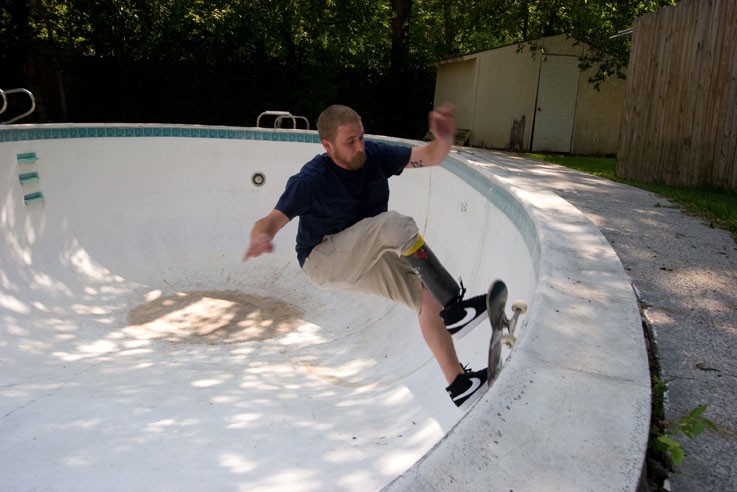
This year’s event, on Nov. 7 at the Janette Kennedy Gallery in Dallas, will offer 200 boards for auction. Coker hopes to raise $100,000, to be split between the Dallas arts community and Scottish Rite.
“The art was stunning,” he said. “And the beauty of what we’re doing with the whole skateboarding thing is that we’re making a lot of people smile. We’re outlaws, we’re skateboarders, but we’re the good pirates.”
Coker was one of the few wearing a helmet at the pool, and it stood him in good stead. After a trick high on the wall, his board came out from under him. He went down, and his helmet hit the pool floor with a loud crack. He came back to the side shaking his head.
“With pools you’re required to utilize the natural forces combined with timing,” he said. “There’s a critical moment where you need that confidence that you can make it up the wall. If you get scared of that wall for even a split second, you can’t do it.”
He apologized for not skating well. “Five months ago I would have skated that pool better than I did. But I had a fall without my helmet and needed 22 stitches, so I’m still getting my chops back.”
Coker, like most of the others, skates on the street and in organized slalom races. The only thing he doesn’t skate anymore are public parks. The problem, he said, is that while public skate parks put up notices that the ramps should not be used for bikes, scooters, or roller blades, few parks enforce the rule. “And since I’m going 25 miles an hour and have a split second to decide whether I’m going to hurt myself or run over a 6-year-old, well, I’d rather not be in that position anymore. My worst injuries have come trying to avoid people in skate parks.”
Two years ago, he built his own private park, designed by Oliver Bradley, another of the Sunday skaters. He leased a warehouse in south Dallas and bought some ramps and equipment from a skate park that was going out of business. Members get keys and pay monthly dues. And he and some of the others who were at the Arlington pool are putting the finishing touches on a bowl – something like a swimming pool – out behind the warehouse. No bicycles will be allowed.
The park will remain private, but Coker and Stubbs and other club members plan to open it to the children of servicemen and women serving overseas. And, perhaps trying to make up for all the vacationing neighbors’ pools they skated when they were young, the informal group is also taking pains to get their sponsor companies to donate new boards to kids who’ve never had good ones.
“A place like Irving has a great skate park,” said Stubbs. “But a lot of the kids who use it are poor. Their parents haven’t got the $90 it takes for a good board, so they are riding around on things in awful condition. Some of what kids ride is just plain dangerous. So we all do our best to get our sponsors to donate, and then we take our old stuff – still good by most standards – and get those products into those kids’ hands. Skaters take care of their own.”
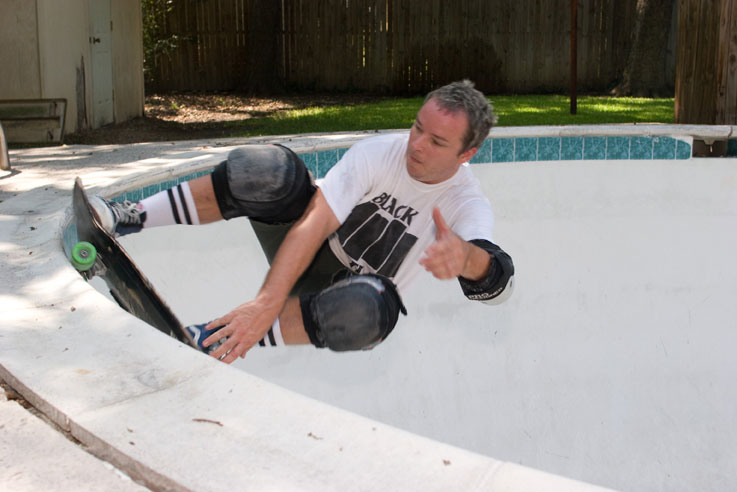 In the end, age and injuries aren’t enough – not yet, anyway – to keep the skaters out of the pool.
In the end, age and injuries aren’t enough – not yet, anyway – to keep the skaters out of the pool.
What keeps these guys going, Coker said, is simple: “The chance to go vertical. The speed, the quickness. It’s just fun.”
How long will he be able to do it?
“I ought to be able to keep going vertical ’til I’m 65, I think. After that I may have to hang it up in terms of pool skating, but I ought to be able to keep doing lazy-8s, just easygoing skating, as long as I’m alive.”
The others feel the same. Mike Nieman rattled off his list of serious injuries – he’s had four knee surgeries and a wrist surgery along with assorted broken bones – but said it comes with the territory. “Nobody who skates hard gets away without getting hurt. But it’s worth it anyway.”
Ripper has had two broken collarbones, back injuries, concussions, and a broken wrist. “Now that I’m asked, I guess it has taken its toll,” he said. “But then grinding that pool edge is the best thing in the world for me. I guess I’ll keep skating as long as I can still do that and get that rush.”
Bradley, 34, who’s from England, calls pool skating a dream, “because we don’t have it back home.” He broke his arm last year, but, “It just made me appreciate skating even more,” he said.
Statman said age has made him quit riding stairways and rails, but he’s made up for that by becoming nationally competitive in downhill skateboard racing and slalom events. “I quit the street stuff when, even when I pulled it off, I hurt more than it was fun. But pool skating, slaloms, downhill – they’re all still fun. When you can go to the hills in Oklahoma and hit 60 miles per hour going downhill on a skateboard, that’s a pretty good rush. As for the possibility of getting hurt, well, you can get hurt walking down the street. But you can’t let that get in your way.”
“We like the feel of being able to propel ourselves at great speed on a board and four wheels,” said Stubbs. “That’s why I skate, and I think that’s what a lot of other guys feel too. And I hope I never wake up feeling like I’m too old to be doing it.”
When he’s speeding down the bottom of a pool, coming up to a wall, he said, “in that moment I’m totally free. Nothing else matters.”











